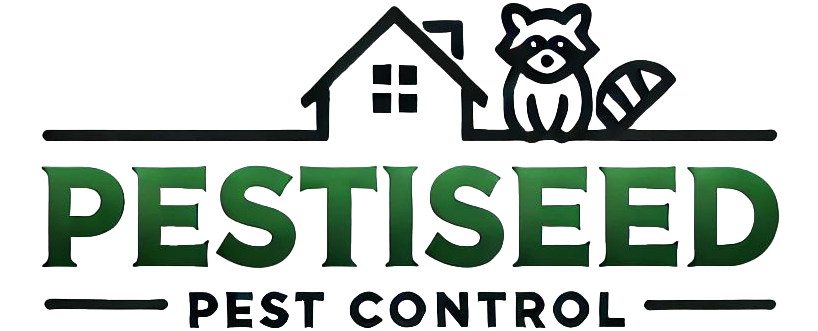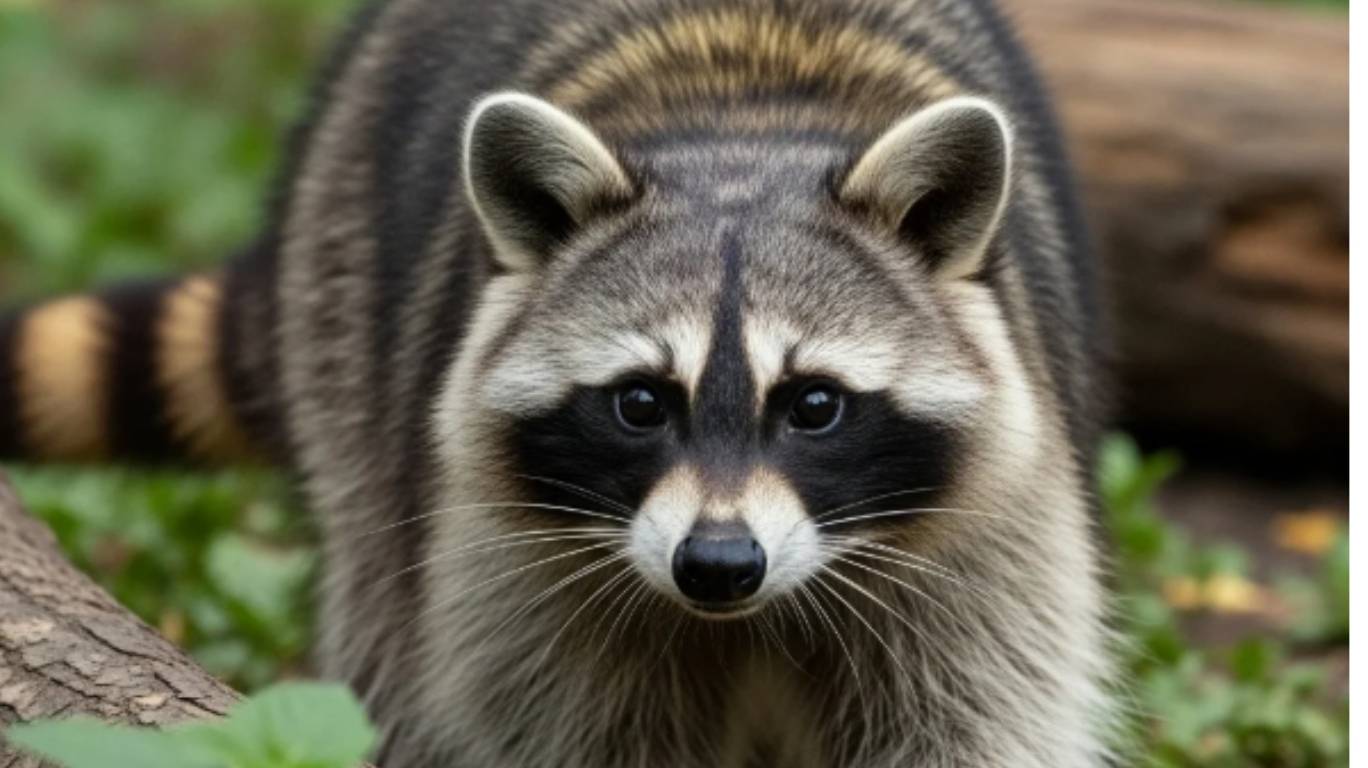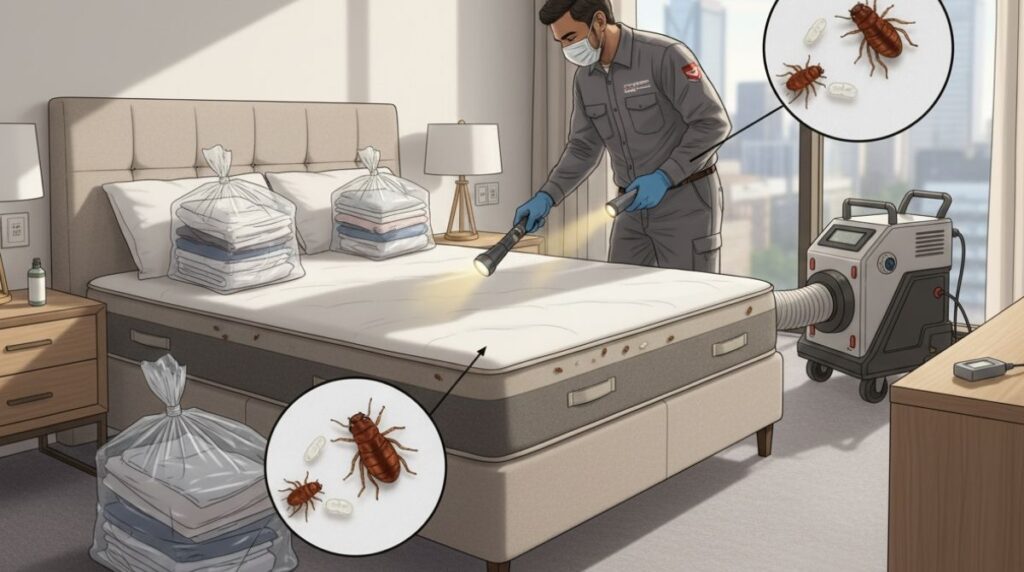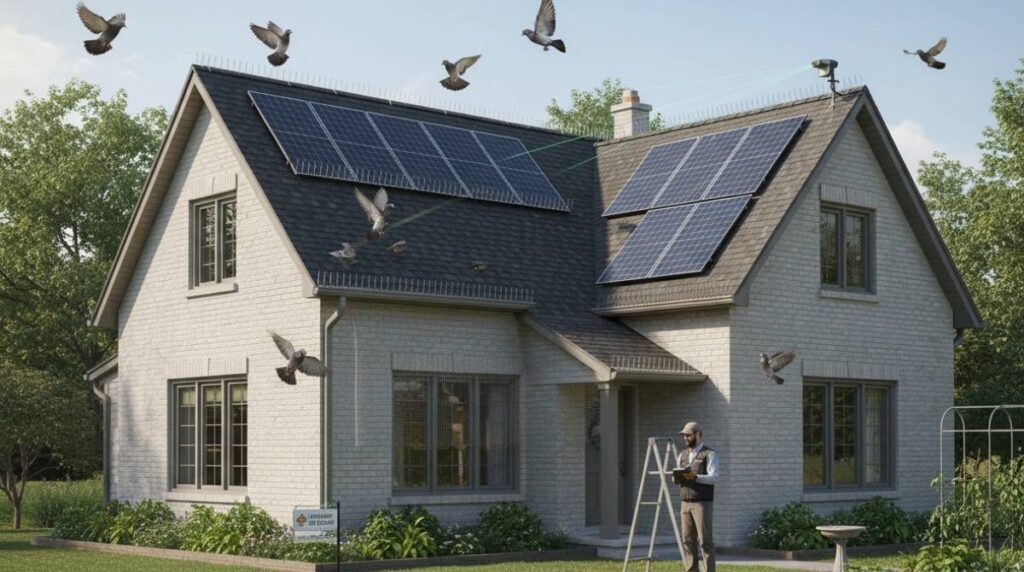Last week, we got a call from a Toronto homeowner. She thought her house was haunted. The truth was much simpler. Raccoons had moved into her attic. We see this mistake all the time in our 5+ years experience. Most people don’t know what to look for. Here’s how to get rid of raccoons in attic Toronto, tell if you have unwanted furry guests.
What Your Ears Tell You About Attic Invaders
Your noisy attic speaks volumes about what’s living there. Raccoon noises are very different from other pests. We tell our Toronto clients to listen carefully. Night activity is the biggest clue. These masked bandits are most active after sunset. You’ll hear heavy footsteps above your bedroom. The sounds are much louder than mice or squirrels.
Raccoon noises include chattering, chittering, and scratching sounds. Mother raccoons make soft purring sounds to their babies. The timing of activity matters most. Squirrels are daytime creatures. Mice make tiny scurrying sounds. Raccoons sound like small people walking around up there.
Physical Proof They Leave Behind
Visual signs tell the real story of your attic invasion. Raccoon tracks are easy to spot in dusty areas. They look like tiny human handprints with long fingers. The tracks are about 3 inches long. You’ll see them near entry points and food sources.
Raccoon droppings are another dead giveaway. The raccoon feces look like large dog poop. They’re dark brown and about 2 inches long. Always wear gloves when checking for waste. Raccoon droppings can carry dangerous diseases. Torn insulation shows where they’ve made nests. Raccoon damage includes chewed wires and wood. Damage indicators also include holes in drywall and ventilation.
We offer same day availability for Toronto homeowners who find these signs. Our licensed experts provide safe solutions for removal and cleanup. Fast service starts at just $99 with no hidden fees. Call our 24/7 service line when you spot these warning signs. We’re local trusted professionals who guarantee our work. Enjoy 10% off all pest control services when you mention this guide.
Why Raccoons Choose Toronto Attics
Toronto raccoons have figured out something brilliant. Our city environment offers everything they need for survival. These smart urban raccoons don’t just randomly pick homes. They scout locations like tiny real estate agents.
Attic space becomes prime real estate for good reasons. Toronto’s harsh winters make warm shelter essential for survival. We’ve noticed raccoons prefer older neighborhoods with mature trees. The seasonal patterns are predictable too. Spring brings babies, so mothers need safe nurseries. Summer heat drives them to cooler upper levels. Fall means stocking up before winter hits hard.
What Makes Toronto Perfect for Raccoons
Our breeding preferences research shows interesting trends. Female raccoons choose attic space for raising babies every spring. The city environment provides endless food sources nearby. Garbage day becomes their shopping trip. Bird feeders turn into raccoon buffets. Pet food left outside disappears overnight.
Toronto raccoons have adapted to our urban lifestyle perfectly. They’ve learned our schedules and routines. We see them crossing busy streets like seasoned pedestrians. Traffic lights don’t scare them anymore. These clever creatures use storm drains as highways. Warm shelter in attics beats hollow trees any day.
Health Dangers From Raccoon Waste
Raccoon feces carries deadly raccoon roundworm eggs that survive for years. We see many Toronto homes with dangerous attic contamination from raccoon waste. Raccoon urine soaks into insulation and creates strong ammonia smells. Sick raccoons spread diseases through their droppings and saliva.
The raccoon roundworm can cause blindness and brain damage in humans. Children face the highest risk from contaminated attic dust. We always wear protective gear when cleaning raccoon feces. Even dried waste becomes airborne and dangerous to breathe.
Costly Property Damage From Raccoons
Torn insulation from raccoon activity costs Toronto homeowners thousands. We have seen attic damage reach $15,000 in severe cases. Raccoons rip apart insulation to build nests for babies. Structural damage happens when they chew wooden beams and supports.
Electrical hazards increase when raccoons chew on wires in attics. House fires can start from damaged electrical systems. Attic repairs include replacing insulation, fixing vents, and sealing entry points. Most insurance companies do not cover wildlife property damage costs.
Step by Step Get Rid of Raccoons in Attic Toronto Process
Getting raccoons out of your Toronto attic takes careful planning. We need to follow proper steps to keep everyone safe. Raccoon removal service works best when you know what to do first. Most Toronto homeowners can handle DIY removal with the right tools and knowledge.
Safe removal means protecting yourself and the raccoon family. We always check for baby raccoons before starting any work. The breeding season runs from April to September in Toronto. Mother raccoons get very protective during this time.
Step 1: Find Where Raccoons Get Inside
Raccoon entry points are usually on your roof or near the roofline. We start our roof inspection by looking for torn shingles or loose boards. Check around vents, chimneys, and where different roof sections meet. Look for dark stains or scratches around holes.
Attic access points can be as small as four inches wide. Raccoons are amazing climbers and can squeeze through tight spaces. We use binoculars to check high areas safely from the ground. Take photos of damage so you remember where to seal later.
Step 2: Listen for Baby Sounds
Baby raccoons make high pitched crying sounds different from adults. We listen carefully during dawn and dusk when families are most active. Mother raccoon sounds are deeper chattering and growling noises. The raccoon family stays together until babies can survive alone.
During breeding season, never try removal if you hear baby sounds. Wait eight to ten weeks for babies to grow big enough. Orphaned raccoons will die without their mother’s care. Toronto wildlife laws protect raccoon families during nesting time.
Step 3: Set Up Exit Doors
One way doors let raccoons leave but not come back inside. We install these doors over the main entry hole after babies leave. Raccoon exclusion works better than trapping in most cases. Humane raccoon removal means letting animals escape on their own.
Buy professional grade one way doors from pest control stores in Toronto. Install the door when you know all raccoons are outside feeding. We usually do this work in early evening before they return. Check the door daily to make sure it stays in place.
Step 4: Use Backup Traps
Cage traps work when one way doors are not enough. We set raccoon traps along travel paths in your yard. Live traps must be checked every few hours by Toronto law. Trapping requires patience and the right bait.
Use sweet foods like marshmallows or fruit as bait. Place cage traps on flat ground away from your house. Raccoon traps need to be big enough for adult animals. We remove caught raccoons quickly to reduce stress on the animal.
Step 5: Try Natural Scent Deterrents
Raccoon eviction fluid contains scents that warn of male raccoon territory. Mother raccoon removal becomes easier when she smells danger signals. This natural repellent works best during early removal attempts. We apply the fluid near entry points and nesting areas.
Raccoon eviction fluid comes from pest control suppliers or online stores. Spray or soak rags with the fluid every few days. The scent tells mother raccoons to move their babies elsewhere. This method works slowly over several weeks.
Step 6: Clean Up the Mess
Attic restoration starts with removing all raccoon waste and contaminated materials. We wear masks and gloves for disinfection work. Clean every surface the raccoons touched or marked. Attic cleaning prevents disease and future animal problems.
Raccoon waste carries dangerous germs that make people sick. Use bleach solution to kill germs on wood and metal surfaces. Replace damaged insulation and seal all holes completely. Professional attic restoration costs less than health problems later.
We also offer related services like:
Best Raccoon Repellents for Toronto Attics
Raccoons hate strong smells and bright lights. We have tested dozens of repellents in Toronto homes. Some work great while others waste your money. Commercial raccoon repellent products offer quick results for busy homeowners. Natural repellent methods cost less but need more patience. Attic fogger for raccoons covers large spaces fast. DIY solutions using household items work surprisingly well.
Most Toronto families try natural deterrents first before buying products. Smart homeowners combine both methods for best results. Professional grade repellents last longer than cheap store brands. We recommend starting with natural methods then upgrading if needed. Application methods matter more than the product you choose. Wrong timing ruins even the best raccoon repellent efforts.
Commercial Raccoon Repellents That Actually Work
Professional grade repellents contain stronger ingredients than DIY options. We use commercial raccoon repellent sprays in most Toronto jobs. Attic fogger for raccoons fills every corner with scent deterrent. These products work faster than homemade mixtures every time. Predator urine sprays fool raccoons into thinking danger lurks nearby.
Most hardware stores in Toronto carry decent repellent options now. Application methods vary from spray bottles to automated foggers. Granular repellents work well around attic entry points too. Effectiveness depends on reapplying products every few weeks. We tell clients to expect results within three days. Product recommendations change based on attic size and raccoon activity level.
Natural DIY Repellent Methods That Save Money
Ammonia soaked rags create strong odors raccoons absolutely hate. We place these near known entry points for quick results. Bright lights confuse nocturnal raccoons and discourage attic use. Motion activated LED strips work better than constant lighting. DIY solutions using dish soap and cayenne pepper spray surfaces.
Radio noise bothers raccoons trying to rest during daytime hours. Natural repellent combinations work better than single ingredient approaches. Apple cider vinegar mixed with garlic creates powerful odor barriers. Application methods for homemade repellents require more frequent reapplication. Most Toronto homeowners see results within one week using these. Effectiveness improves when you combine multiple natural deterrents consistently.
Raccoon Proofing Your Toronto Home
Raccoon prevention starts with making your home less appealing to these clever bandits. We’ve helped hundreds of Toronto families keep raccoons out of their properties over the past five years. The secret lies in two simple steps. First, block their entry routes with structural modifications. Second, remove what attracts them through smart yard maintenance. Think of it like childproofing your home, but for furry intruders who can open garbage cans.
Block Their Highway Into Your Home
Roof vents are like open doors for raccoons in Toronto. We recommend installing heavy duty mesh screens over all vent openings. The mesh holes should be smaller than one inch. Regular window screens won’t work because raccoons tear through them easily. Chimney caps are another must have protection. Many older Toronto homes still have open chimneys. Raccoons love to climb down and set up camp.
Siding gaps around your home’s exterior need immediate attention. Walk around your property and look for loose boards or holes. Pay special attention to areas where different building materials meet. Crawl space openings under porches and decks are raccoon favorites. Install sturdy wire mesh over these areas. Make sure the mesh extends six inches underground. Raccoons are excellent diggers too.
Make Your Property Boring to Raccoons
Trash cans are the number one raccoon magnet in Toronto neighborhoods. We always tell clients to invest in heavy duty lids with locking mechanisms. Put garbage out on collection morning, not the night before. Raccoons are most active between sunset and sunrise. Pet food left outside is like ringing a dinner bell. Even dry kibble in sealed containers can attract these persistent animals.
Bird feeders cause more raccoon problems than most people realize. Spilled seeds create feeding areas that raccoons remember and revisit. Clean up fallen seeds weekly during active feeding seasons. Yard maintenance includes removing brush piles and overgrown vegetation. Raccoons use these areas as hiding spots during daylight hours. Trim trees that hang over your roof or touch your house. These branches are like highways leading directly to your attic.
When To Call Professional Raccoon Removal in Toronto
Most Toronto homeowners try DIY methods first. We get it you want to save money and handle things yourself. But some situations need professional removal right away. Complex situations like mother raccoons with babies require special skills. These animals get aggressive when protecting their young. Pestiseed Pest Control Licensed experts know how to handle dangerous scenarios safely.
Legal requirements in Toronto are strict about wildlife removal. You cannot just relocate raccoons anywhere you want. The wildlife regulations say you must follow specific rules. Breaking these Toronto bylaws can cost you big fines. Professional Toronto services know all the local laws. We handle permits and follow every rule properly.
Toronto Raccoon Removal Laws and Regulations
Toronto has tough rules about removing raccoons from homes. The wildlife regulations protect these animals year round. You cannot harm raccoons or move them during baby season. Toronto bylaws require humane removal methods only. Legal requirements include proper permits for some removal work.
Raccoons in your attic can cause costly damage fast. Our Raccoon Removal Hamilton experts provide safe, humane attic cleanup and prevention, while Raccoon Removal Richmond Hill specialists ensure lasting protection from future infestations.
Breaking these rules brings heavy fines from the city. Licensed experts stay updated on all changing laws. We know which months allow certain removal types. Professional removal teams handle all paperwork for you. This keeps you safe from legal trouble.
Benefits of Professional Toronto Services
Licensed experts bring years of training to your problem. Pestiseed pest control use safe removal methods that protect your family. Guaranteed service means the job gets done right the first time. Our tools and techniques work better than store items.
Attic restoration comes included with most professional Toronto services. We clean up all raccoon waste and damage. Same day service gets raccoons out before they cause more problems. Licensed experts also seal entry points permanently. This stops future raccoon invasions completely.
Cost of Raccoon Removal in Toronto
Toronto pricing varies based on your specific problem size. Simple one raccoon jobs cost less than family removals. Raccoon removal cost includes inspection and basic sealing work. Pestiseed Pest control removal starts $99 for standard attic. DIY vs professional costs show interesting differences when calculated properly.
DIY methods seem cheap but often fail. You buy traps, repellents, and sealing materials repeatedly. Failed attempts let raccoons cause more expensive damage. Professional Toronto services fix everything in one visit. Affordable rates include warranty protection and follow up visits. No hidden fees means the quoted price stays the same. Service packages bundle inspection, removal, cleanup, and prevention together. Most companies offer payment plans for larger restoration jobs.
Frequently Asked Questions of Raccoons
Living in Toronto, we’ve heard every raccoon question imaginable. These masked bandits love our city’s attics more than Tim Hortons coffee. Here are the most common questions homeowners ask us about raccoon removal and what actually works.
Most folks panic when they first hear scratching sounds upstairs. The good news is that most raccoon problems have simple solutions. Let’s tackle the questions that keep Toronto homeowners awake at night.
How Much Should I Pay to Get Raccoons Out of My Attic?
Professional raccoon removal in Toronto costs start $99. This includes inspection, one way door installation, and sealing entry points. But incomplete jobs often cost more later.
What Can I Use to Repel Raccoons From My Attic?
Commercial raccoon repellent works better than home remedies. Attic foggers filled with predator urine scent work well. Ammonia soaked rags make raccoons uncomfortable but need frequent replacement.
Raccoon eviction fluid contains male raccoon scent that scares mother raccoons. Bright LED lights disturb their sleep patterns. Loud radios playing talk shows annoy them too. Combine multiple methods for best results against these stubborn pests.
How Do You Know If Baby Raccoons Are in the Attic?
Baby raccoon sounds are higher pitched than adult chatter. Listen for chittering noises at dawn and dusk. Baby raccoons make sounds like crying kittens when separated from their mom. Adult raccoons make deeper growling sounds.
Mother raccoons move baby raccoon litters frequently for safety. You might hear shuffling sounds as she relocates them. Never attempt removal during breeding season from April to September. Baby raccoons need their mother raccoon to survive.
Is It Legal to Trap Raccoons in Toronto Yourself?
Ontario allows live trapping on your own property. But relocated raccoons often die from stress and unfamiliarity. Toronto bylaws require humane methods only. Poison is illegal and dangerous to pets and children.
Professional removal ensures legal compliance and animal welfare. We use cage traps designed for raccoon size and behavior. One way doors let raccoons leave but prevent their return. This method follows all local wildlife regulations.
How Long Do Raccoons Stay in Attics?
Adult raccoons stay 2-3 months if undisturbed in comfortable attics. Mother raccoons with babies stay 8-10 weeks until babies mature. Without intervention, families return seasonally to successful den sites.
Urban raccoons remember good locations and teach their offspring. Female raccoons often return to birth sites for their own litters. Permanent removal requires sealing all entry points after eviction. Half finished jobs invite return visits.
What Diseases Can You Get From Raccoon Droppings in Attic?
Raccoon roundworm is the biggest health risk from raccoon feces. This parasite causes serious brain and organ damage. Raccoon droppings also carry leptospirosis, salmonella, and E. coli bacteria.
Sick raccoons with rabies are rare but dangerous. Raccoon waste becomes airborne when disturbed during cleaning. Always wear N95 masks and rubber gloves. Attic contamination requires professional cleanup with proper equipment.
Do Raccoons Come Back to the Same Attic?
Yes, raccoons return to successful den sites repeatedly. They have excellent memories for safe, warm locations. Raccoon families pass location knowledge to their young through generations.
Raccoon entry points must be sealed completely after eviction. Female raccoons scent marks attract other raccoons looking for dens. Hot attics in summer and warm attics in winter draw repeat visitors. Only complete exclusion prevents return problems.
What Time of Year Do Raccoons Have Babies in Toronto?
Raccoons breed from January to March in Toronto’s climate. Baby raccoons are born between April and May after 63 day pregnancies. Some female raccoons have second litters in July during good food years.
Breeding season makes removal more complex and legally restricted. Mother raccoon aggression peaks when protecting baby raccoon litters. Wait until babies mature enough to follow mom outside. September through December offers the safest removal window.
[/vc_column_text][/vc_column][/vc_row]



